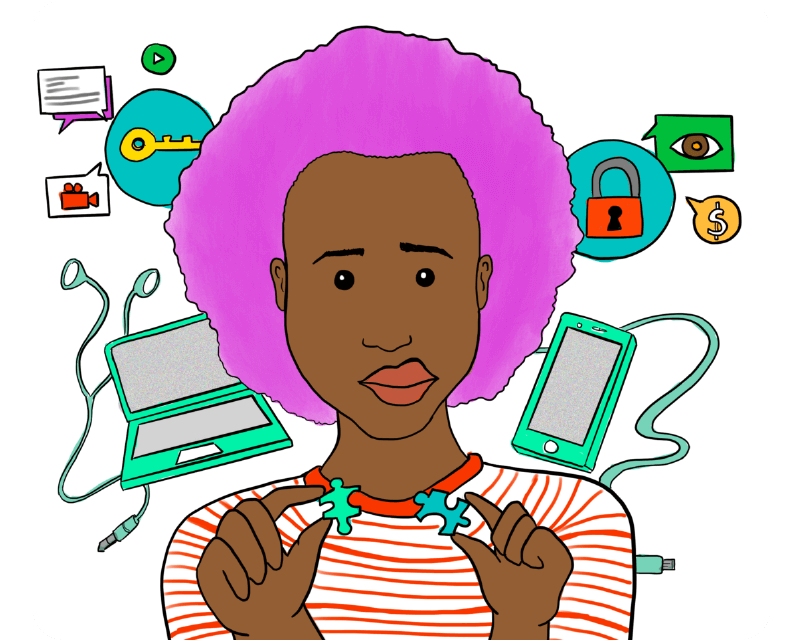By Haley Slafer, Director, Internet Freedom Programs

Quratulain Rehbar felt numb when she found out that someone had posted her personal information and picture to an app listing her “for sale” with over 100 other Muslim women, mostly journalists, politicians, and activists from India. By the time she deleted the Instagram account where someone had stolen her photos, unwelcome messages were pouring in. She knew why she and the others, all of whom had been critical of the Indian government’s policies on religious minorities, had been targeted. “[The intent] was to sexually harass, disgrace, humiliate and hate on women for speaking out,” she told NBC news a year ago.
Coverage of instances of online violence has increased over the last few years, but for many women, these types of stories barely register as newsworthy. For most of us, the digital world does not feel like a safer place than the offline one: abusive comments can invade your daily life, your private photos can be shared publicly, and vicious threats will follow you on your phone. The pervasiveness of the problem has only gotten worse since COVID, and the data backs up the anecdotal: the Economist estimates that 85% of women worldwide have experienced at least some type of online violence.
85% of women worldwide have experienced at least some type of online violence.
The Economist
If you haven’t experienced it personally, online violence can be wholly isolating. That is, in part, because it is usually not taken as seriously as offline violence, despite its unparalleled ability to seep into all aspects of your life. Justice for victims is relatively rare: according to the United Nations, only one in five women live in a country where online abuse is likely to be punished. Due in part to this impunity, women don’t often report it.
Journalists, Human Rights Defenders, and Harassment Online
For women in public-facing professions, like human rights defenders, activists, political figures, and journalists, whose very existence in traditionally male-dominated fields challenges old power structures, the breadth and depth of online violence can be even more horrific. It’s not uncommon for it to lead to physical violence: in a recent report from UNESCO, 20% of the 900+ women journalists surveyed said they had received offline abuse related to instances of online violence.
For women from sexual, ethnic, or religious minorities, the abuse is even worse. Somewhat unsurprisingly, the UNESCO researchers found that the news theme that triggered the most online abuse was gender (49%), followed by politics/elections (44%), and then human rights/social policy (31%).
Ultimately the sheer volume of online harassment and the lack of accountability for its perpetrators cause a chilling effect as women self-censor or leave their fields entirely, with severe consequences. Online violence and disinformation campaigns against women are such effective political tools, that they are used specifically to silence women. Journalists and activists aren’t the only ones targeted: women politicians face huge backlash as well. In 2021, Australian Parliamentarian Fiona Patten announced she was leaving social media after receiving “appalling abuse” online because of her support of COVID-19 restrictions.
The sheer scale and pervasiveness of online violence against women can generate hopelessness and resignation. However, the need to break the bias, empower targeted women, and generate more open conversations about online harassment has never been more dire – and brave activists and journalists around the world are picking up the onus of finding a solution.
Digital safety as empowerment
Digital security education can help women stay safe online and thrive politically, socially, and economically. But there are not a lot of options for local, contextualized support around the unique threats that women face. And unfortunately, social and cultural pressures often prevent women from pursuing digital security education at all.
At Internews, we have been providing entry-level, co-ed digital security trainings to journalists and human rights defenders all over the world since 2008. For years, we struggled to find enough women journalists to participate. When we asked women in our network why they hadn’t applied, many said they didn’t feel qualified to engage in “digital security” because they felt the issues required a background in computer science, an expertise most didn’t have. Men, it turned out, were not as concerned and turned up anyway.
That’s why in 2017 we founded Safe Sisters, together with Uganda-based nonprofit DefendDefenders. Safe Sisters is an approachable, entry-level, digital safety fellowship training program that meets women where they are, uses skills they already know, and reflects their local contexts.
Through Safe Sisters, we have trained dozens of women journalists and activists in Sub-Saharan Africa and South Asia on digital safety best practices, tools and techniques, and how to train others. In turn, they have gone on to train hundreds more people – including men and boys — about online harassment. There is strong evidence of the lasting impact of the program: five years after the pilot, 80% of the Safe Sisters are actively involved in digital safety – including some who have changed careers to pursue it professionally.
80% of Safe Sisters participants are actively involved in digital safety – including some who have changed careers to pursue it professionally.
Haley Slafer
Programs like Safe Sisters, especially if supported at scale, are a piece of the solution – but there is a lot more that needs to be done. Social media companies must be held accountable for their part in enabling harassment; governments need to enact laws that protect women’s rights online and deter abuse; and countries that already have protection laws on the books need to ensure that they are being enforced.
With an online gender gap that continues to grow, we cannot afford to backslide when it comes to women’s representation in civil society and journalism. Women urgently need better, more targeted support, not only to stay safe online, but also to seize the full economic, political, and social benefits of the internet.